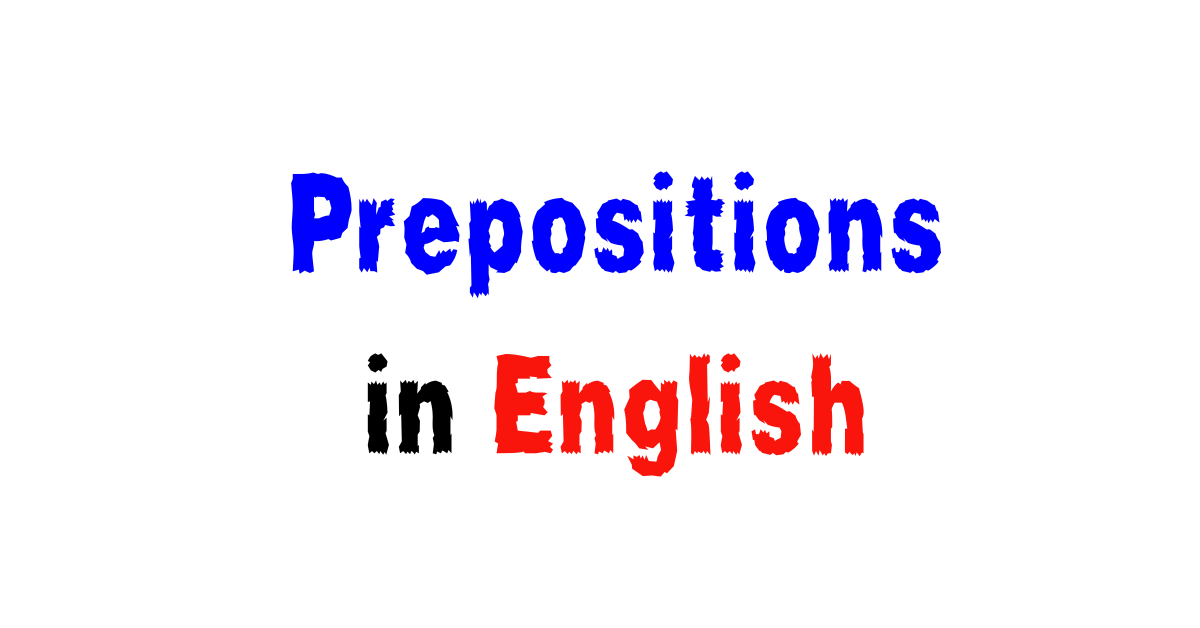
Prepositions in English
Prepositions in English
Use Prepositions Correctly in Every English Sentence.
this lesson is designed for English learners who want to clearly understand the use of prepositions in many different kinds of English sentences.
Why do English speakers say:
a person gets on a bus and into a taxi, on a plane and into a car; we arrive in New York at Kennedy Airport on Wednesday at 3 p.m. in November; we sit at a desk but we sit in a chair; our hands are on the desk but our pencil is in our hand; we say we did something for him and then did something to him; I like my friend because he’s like my brother; we have been talking about school since 2 p.m. for 3 hours outside the building that is close to the bank; the book is underneath the counter, beneath the bookshelf, under the window, near the door, beside the TV, which is next to the chair that is over the box that is on the floor . . . whew
.Does some of this sound confusing to you? Well, don’t worry
This Focus On English lesson is about English prepositions and will help you to understand and use English prepositions correctly in every situation.
Chapter 1 – Using Prepositions to Talk About Time
Using the prepositions:
ahead, behind, at, on, in, by, within, under, during, over, since, from, for and after
when talking about time in English
Ahead:
Use ahead to talk about being earlier than expected
Examples:
- The train is ahead of schedule. It was supposed to arrive at 9 a.m. but the time is now 8:55 a.m. and it is here!
- this is my first day of work , so I arrived at the office ahead of time . ( Meaning: earlier than I was supposed to be there.)
Behind:
Use behind to talk about being later than expected
Examples:
- The train is behind schedule. It was supposed to arrive at 9 a.m.
but the time is now 9:05 a.m. and it’s not here yet!.
- My watch says 12:30 p.m., but the time on the bank clock says 12:40 p.m. My watch must be behind.
On:
Use on for day names, like Monday or Tuesday
Examples:
- My friends come to visit me on Wednesday.
- We have an important exam on Friday.
On:
Use on in expressions like on time;
on time means at the correct time or agreed upon time.
Example:
My boss does not want me to come to work late. He wants me to come to work on time.
At:
Use at to talk about exact clock time.
Examples:
The exam will start at 3 p.m..
The movie starts at 7:15 p.m..
At: Use at
to talk about midnight, noon, night, daybreak, sunset, sunrise, etc.
Examples:
We had lunch at noon.
We woke up at dawn (when the sun comes up).
We went to bed at dusk (when the sun goes down).
At:
Use at in expressions referring to time:
at the moment, at the present time, etc.
Examples:
At the moment, doctors are not sure what causes cancer.
At the present time, we are not hiring any more employees.
In:
Use in to talk about seasons of the year:
Examples:
We will start school in the fall.
Our vacation begins in the summer.
In:
Use in to talk about centuries, years, and months:
Examples:
Cars were invented in the nineteenth century.
We will finish class in May.
We will graduate in 2012.
In:
Use in to talk about blocks of time:
Example:
The woman said that she expects to have children in the future.
In:
Use in to talk about named times of the day: morning, afternoon, and evening:
Examples:
- We have tea in the morning.
- We eat lunch in the afternoon.
- We have dinner in the evening.
In:
Use in to talk about months of the year.
Example:
- I will complete my English course in February.
In:
Use in to talk about years.
Example:
I came to this country in 2002
In:
Use in in expressions like in time.
Example:
- He was just in time for dinner.
Meaning: he arrived when dinner was about to be served; at the correct time.
What is the difference between in time and on time?
In time means that something has happened approximately at the same time as something else is happening or about to happen.
Example:
We are about to have dinner, and you are just in time to join us.
On time means that something has happened exactly at the agreed upon time.
Examples:
The student was on time for school.
School begins at 8 a.m. The student was on time.
Example:
He was on time for dinner.
This means that he arrived at exactly or near the time when dinner was being served (just before, or exactly when dinner was being served)
Example using in time:
We said dinner was at 6 p.m. and he arrived in time. (This means that he arrived sometime approximately around the agreed upon time of 6 p.m.. )
Within:
Use within to talk about something happening sometime inside of a specific time frame.
Example:
The bus should arrive within the next 15 minutes. (Meaning sometime more than 1 minute and less than 15 minutes. So, for example, if it is 8 p.m., the bus should arrive sometime between 8 p.m. and 8:15 p.m. The bus is not expected to arrive at 8:15 p.m. exactly nor at 8 p.m. exactly, but some time in between these two times.)
Under:
Use under when talking about something happening in less than a certain amount of time.
Example:
- I’m sure the train will be here in under an hour. (Meaning in less than an hour).
Over:
Use over when talking about something that takes more than a certain amount of time.
Examples:
I have been waiting here for you for over an hour.
The bus took over an hour to get to its next stop.
During :
Use during to talk about the time span in which something happened.
Example:
She cannot sleep well. She woke up several times during the night. (The time span was the nighttime hours when she was trying to sleep.)
Since:
Use since to talk about situations that began in the past and continue to the present.
Example:
- I haven’t felt well since I left my home country.
Use since to refer to a specific time in the past like, for example, 1994 or 2 p.m.
For:
Use for to talk about situations that began in the past and continue to the present.
Examples:
I have been waiting here for the plane for two hours.
We have been taking this exam for 3 hours and I am tired.
Use for to talk about consecutive time like, for example, for 50 minutes or for 20 years.
From:
Use from to talk about situations that will begin now or began at a certain time and continue into the future.
Example:
Last year we lost a very important soccer match to our rival. We were very sad. From that time on we never lost another game to our rival.
From that time on means beginning with that time and continuing into the future.
By:
When talking about time, use by to mean up to a certain time.
Example:
They will finish building our new house by next March.
Quick Review –
Using Prepositions When Talking About Time
Let’s review the use of on, at and in for time sentences
Use on for day names, like Monday or Tuesday.
Use on in expressions like on time.
Use at to talk about exact clock time.
- The exam will start at 3 p.m.
Use at to talk about midnight, noon, night, day, etc.
For example:
- we had lunch at noon.
- We woke up at dawn.
- We went to bed at dusk (when the sun goes down).
Use at in expressions referring to time: at the moment, at the present time, etc.
For example:
- At the moment, we are not sure what causes cancer.
Use in to talk about what will or may happen in the future:
I will arrive in Tokyo in 4 days.
Use in to talk about seasons of the year.
For example:
- we will start school in the fall.
- Our vacation begins in the summer.
Use in to talk about centuries, years, and months.
For example:
- cars were invented in the twentieth century.
- We will finish class in May.
- We will graduate in 2012.
Use in to talk about blocks of time.
For example:
- I expect to have children in the future.
Use in to talk about named times of the day.
- For example: We have tea in the morning.
- We eat lunch in the afternoon.
- We have dinner in the evening.
Use in to talk about months of the year.
For example:
- I will complete my English course in February.
Use in to talk about years.
For example:
I came to this country in 2001.
Use in in expressions like: in time.
For example:
He was just in time for dinner.
Snapshot – Using Prepositions When Talking About Time
What is the difference between in time and on time?
In time means that something has happened approximately at the correct time.
On time means that something has happened exactly at the right time.
He was in time for dinner. Means that he arrived at some time just before dinner was being served.
We said dinner was at 6 p.m. and he arrived on time. Means that he arrived exactly at 6 p.m.
On:
Use on for day names, like Monday or Tuesday
Examples:
- My friends come to visit me on Wednesday.
- We have an important exam on Friday.
On:
Use on in expressions like on time; on time means at the correct time or agreed upon time.
Example:
My boss does not want me to come to work late. He wants me to come to work on time.
At :
Use at to talk about exact clock time.
Examples:
- The exam will start at 3 p.m..
- The movie starts at 7:15 p.m..
At :
Use at to talk about midnight, noon, night, daybreak, sunset, sunrise, etc.
Examples:
- We had lunch at noon.
- We woke up at dawn (when the sun comes up).
- We went to bed at dusk (when the sun goes down).
At :
Use at in expressions referring to time: at the moment, at the present time, etc.
Examples:
At the moment, doctors are not sure what causes cancer.
At the present time, we are not hiring any more employees.
In:
Use in to talk about seasons of the year:
Examples:
We will start school in the fall.
Our vacation begins in the summer
In:
Use in to talk about centuries, years, and months:
Examples:
- Cars were invented in the nineteenth century.
- We will finish class in May.
- We will graduate in 2012.
In:
Use in to talk about blocks of time:
Example:
The woman said that she expects to have children in the future.
In:
Use in to talk about named times of the day: morning, afternoon, and evening:
Examples:
- We have tea in the morning.
- We eat lunch in the afternoon.
- We have dinner in the evening.
In:
Use in to talk about months of the year.
Example:
I will complete my English course in February.
In:
Use in to talk about years.
Example:
I came to this country in 2001.
In:
Use in in expressions like intime.
Example:
He was just in time for dinner. Meaning: he arrived when dinner was about to be served; at the correct time.
Chapter 2
Using the prepositions :
above, across, after, against, along,among, around, at, below, beside, between, beneath, from, in, off, on, under, and towards
when talking about place or location.
Above :
When talking about place, use above to mean something that is higher up than something else. Examples:
- Oh look at that beautiful bird flying above our heads.
- The president is above all other managers in the company.
- The ceiling is above the floor.
Across :
When talking about place, use across to express: from one side to the other.
Examples:
- The chicken walked across the street to eat some corn.
- The chicken walked across the busy street safely.
- The cruise ship sailed across the ocean to Europe.
- The man walked across the bridge to visit his secret lover.
After:
Use after when talking about the ‘next one’ when talking about place or location.
Examples: ·
- The food store is the next building after the bank.
- The shopping mall is located on the next block after the high school.
Beside:
Use beside when talking about something that is at the side of or next to something or someone. Examples:
The clothing store is beside the bank.
The student sat beside the teacher while the teacher corrected his exam.
Against:
When talking about place or location, against means something contacting or touching something else, pressing on it or pushing on it.
Examples: ·
- The woman leaned against the wall waiting for her boyfriend to meet her. ·
- The traffic was so bad that cars were almost against one another.
Along :
Along means over the length of something.
Example:
- The man walked along the busy road on his way to work.
Among:
among means something or someone in a group of people or things. There are usually more than two people or things in the group.
Example:
The woman walked in the park among the flowers and trees.
Compare: She walked between two tall trees.
Around :
Around, first meaning: means in the immediate vicinity. Another way to say this is: something that is close by or near
Example:
- The new hotel is around here, but we are not exactly sure where.
Around :
Around, second meaning: when we talk about a place being on the other side of something (sometimes obscured from your view by something).
Examples:
- The bank is around the corner from here.
- The police station is around the other side of the building.
Around :
Around, third meaning: moving here and there, randomly.
Examples:
- The couple walked around the neighborhood.
- The boy rode his bicycle around the town.
At :
Use at to express being in front of, or up to something, but not in it.
Examples:
He arrived at the train station at 3 p.m..
Compare this with: He went into the train station after he arrived.
He was in the train station for 2 hours before his train arrived.
The train took him to the airport.
He was at the airport by 6 p.m..
He went into the airport to get his ticket.
He was in the airport for 3 hours before his flight.
The trash is kept at the back of the airport building.
In:
Use into talk about your location within a city, state, country or other named political area.
Examples:
I will arrive in Tokyo in 4 days. (Not at Tokyo)
He arrived in New York on Wednesday.
Behind :
Behind means at the back of or the rear of something or someone.
Examples:
- The trash is kept behind the building.
- The boy watched the house burn while his little sister hid behind him.
On:
Use on to talk about something in contact with or over a surface
Examples:
- The book is on top of the desk.
- The book is on the desk. The picture is on the wall.
- The clock is on the wall.
- The map is on the wall.
- The light is on the ceiling.
Under, beneath and below:
You can use under, beneath and below in similar ways when you want to express something being physically lower than something else.
Examples:
- His feet are under the desk.
- His feet are beneath the desk.
- His feet are below the desk.
Chapter 3 –
Using Prepositions when Talking About Transportation and Traveling
Using the prepositions in, on, at, into, off, across, from to, along and between when talking about transportation and traveling
On:
Use on to talk about trains, buses, and planes. (Contrast with in.)
Examples:
- I got on the bus to go to the center of the city.
- When we got on the plane, we had a difficult time finding our seats.
- We got on the train just in time; the train was about to leave.
- The man got on the train and then on a plane to New York.
Using in and inside note: it is true that you are inside the bus, train or plane when you are traveling, but English speakers say “I’m on a bus to Seattle”,
for example, if someone calls them on their cell phone. It is more common for English speakers to use in or inside when talking about public transportation,
for example, when they are talking about things that may have happened while they were traveling, or things that were observed inside the transportation vehicle.
Examples:
- There was a lot of noise inside the bus while we were going home.
- All of the passengers in the plane were enjoying the movie.
- The lights in the train were very bright.
In and Into:
Use in and into to talk about taxis, cars and limousines.
Example
- The businesswoman left her house at 10 p.m. and then got into her car and drove to work.
- The two students waved at the taxi to stop. When the taxi stopped, they got in and told the taxi driver where they wanted to go.
By:
Use by to talk about how you traveled; what form of transportation.
Examples:
- The family traveled by plane to Beijing.
- The boy went to school by foot.
- The businesswoman traveled to Frankfurt by train.
- We went to the movies by bike.
Off :
Use off in the phrasal verb, to get off, to talk about disembarking and arriving at a destination. Examples:
The businessman took the train to New Jersey and got off in Newark.
We are taking a plane to Dallas but we are getting off in Reno, Nevada. ( Note: Don’t use get off when referring to a taxi, car, or limousine (for example, don’t say “I got off the taxi”)
Use get out of or arrived in a taxi, car or limousine.
For example:
I arrived in New York in a taxi. I got out of the taxi, paid the taxi driver, and went inside the train station to catch the next train to Philadelphia.)
Between:
Use between to talk about distance from one location to another location.
Example:
What is the distance between New York and Los Angeles? Oh, it’s about 2400 miles.
From – to:
Use from – to to talk about travel plans or distance from one location to another location.
Example:
How long does it take to travel from New York to Chicago? The distance from Seattle, Washington to Atlanta, · Georgia is about 2,900 miles. Could you tell me how to get to St. Peters Cathedral from here.
Along:
Use along to talk about traveling over a length of road or train track.
Example:
We took a train to Miami, Florida. As we traveled along the tracks, we could see many farms.





